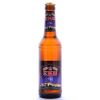EKU Brauerei - EKU Pils
-
ABV:
5% -
Serving Temperature:
43-48° F -
Suggested Glassware:
Pilsner Glass

As you might suspect from the name, EKU Pils is a pilsner, a style that has, very loosely-interpreted, become the most popular style of beer in the world since its invention in 1842. This style originated in the town of Pilsen in the Czech Republic, and it was the first beer to be brewed clear and golden in color (up until that time, beer was dark and rather murky). Though it’s always remained popular in the Czech Republic, the Germans ultimately became the most devoted fans of the style. They added their own twist, too, brewing it somewhat lighter in body and adding an extra bit of hops to give a refreshing, bitter zing.
EKU Pils is a well-carbonated brew, with a big, fluffy, bright white head atop the golden body. Look for notes of spicy and floral hops with a traditional pilsner pale maltiness. We very much enjoyed this easy-drinking brew, with its crisp, clean, and dry finish, and lightly lingering bitter hop-forward aftertaste. This beer is great with food, and would be a great accompaniment for anything from pizza, to whitefish, to Chicken Kiev, to spicy Thai or Indian fare. Prost!
OK students, beer class is in session, please take your seats. Find a nice snifter or tulip glass, or some other similar vessel, and commence pouring your first international beer selection. We shall now begin with a short overview of the superb German beers you’ve received this month.
A number of different styles of beer hail from the town of Kulmbach in Northern Bavaria, but most significant and notable among them is the unique style that was invented there known as “eisbock.” Eisbock is a variant of the traditional and famous “bock” beer popularized by the brewers of Einbeck, Germany, about 175 miles to the northwest of Kulmbach. Originally, bock was not known by that name; instead, the term developed as a colloquialism as “Einbeck Bier” was corrupted into “Ein Bock Bier” (which translates as “one bock beer”), and eventually it simply became “Bock Bier.”
Many years after the bock style established itself in Bavaria, a variant known as “doppelbock” (double bock) was crafted, and this new style also grew in popularity. The Paulaner monks in Munich who invented this style named their beer Salvator (“savior”—and you can actually still buy Salvator and a number of other Paulaner beers at many good specialty beer stores and better beer establishments). Sometime after this, yet another variant of the bock theme was “accidentally” invented. According to local legend, a lone barrel of doppelbock was mistakenly left outside in the yard of a brewery in Kulmbach in the middle of winter’s icy grip. Snow piled up and hid the barrel from sight, and there it lay, forgotten, until spring. When the brewery staff discovered it, they found the barrel had split open a bit, releasing some of the contents, and what remained was partially frozen. After chipping off all the ice in and around the barrel, the enterprising brewers decided to sample the residual beer—after all, you can’t let good beer go to waste! Upon tasting the beer, they realized that it had become concentrated and was far richer than normal, with a significantly higher alcohol content (normal doppelbock is about 6.5-7.5% ABV). This serendipitous discovery was the result of the simple fact that water freezes before alcohol, and in the extreme cold of winter some of the water was forced out of the beer and froze, leaving a thicker brew behind. Essentially, the beer experienced an increase in the proportion of alcohol to volume, inspiring the brewers to set about duplicating, refining, and perfecting the “technique.” The result is one of the beers Franconia is most famous for: “eisbock” (ice bock).
Kulmbacher Eisbock, the originator of the style, is produced by Kulmbacher Brauerei, while a similar brew known as EKU 28 is made by their long-time adversary in the same town, the EKU Brauerei. EKU is short for Erste Kulmbacher Union, so their name translates as “First United Kulmbacher Brewery” (we’ll cover what the “28” refers to in the review below). Begun in 1872, EKU was a fierce competitor of Kulmbacher Brauerei, as well as the other breweries located in the town, such as Sandlerbrau, Mönchshof, and Reichelbrau.
However, through corporate expansion, mergers and takeovers these breweries have been able to set aside their differences, and in 1996 all of them became unified within the same company, known by the simplest title among them: the Kulmbacher Brauerei AG (Kulmbacher Brewery Ltd.). Though united under the same organization and name, each brewery still operates independently, with each brewery producing their own array of well-regarded beers. We’re happy to see the merger didn’t cast any of these excellent beers into the dustbin of history. This month, we bring you two of EKU’s impressive and historic beers for you to savor. Prost!!
For more information (in German) about EKU and Kulmbacher, check out their web site at www.kulmbacher.de.

Unmatched Variety by style, brewery & country
Choose from Five different Beer Clubs offering unmatched variety by brewery,
country of origin, and beer style to suit your specific tastes.


